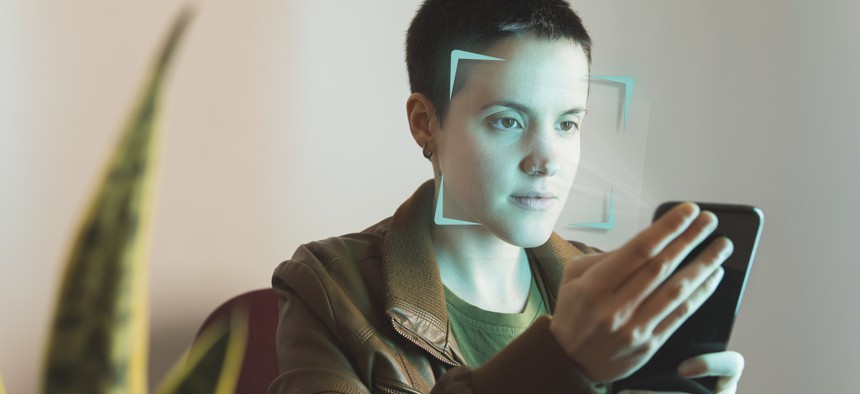Login.gov to add facial recognition tech

Westend61/Getty images
The General Services Administration is changing its digital identity service to allow users to authenticate themselves by matching against a previously submitted government ID.
The General Services Administration will add facial recognition technology to Login.gov, a single sign-on service for Americans to get government benefits and services online, the agency announced Wednesday.
The agency said in its Wednesday announcement it will be rolling out the technology next year. GSA says it will also add another new digital identity verification option for those who don't want to use facial recognition technology. This method is still to be determined but it could involve real-time identity verification via live video chat or other platform.
"Login will provide the options and agencies will decide which parts of it to use," Ann Lewis, director of the Technology Transformation Services at GSA, told Nextgov/FCW. "The goal of providing this broad swath of options is to be able to meet agencies where they are, meet needs where they are, meet the fraud landscape where it is and be able to use all that information and best-in-class technology tools to best serve the population."
The change will likely be felt by many interfacing with the government online.
Login.gov is currently used in at least one program or app in every Cabinet-level agency — and in over 40 federal and state agencies total — for programs like unemployment insurance, online personal health records for veterans and more. Over 70 million people have used Login.gov since the service launched in 2017.
Both the facial recognition and video chat options are part of GSA’s push to bring the service in line with government digital identity standards established by the National Institute of Standards and Technology. GSA’s Inspector General lambasted officials for misleading other federal agencies using the service about its level of compliance in a report earlier this year. Using facial recognition technology is the easiest way to meet those standards online.
“These features will provide virtual and in-person ways for people to verify their identities and securely access vital government benefits and services using convenient, cutting-edge technology, while ensuring their data remains safe,” an agency blog post announcing the change reads. “These offerings will complement Login.gov’s already strong anti-fraud capabilities and provide an even stronger identity verification solution to protect against increasingly sophisticated identity fraud and cyber attacks.”
Login.gov’s in-person option offered at U.S. Postal Service locations is the third way to meet NIST standards for identity proofing, called identity assurance level two. In online situations, Login.gov currently uses data checks of government ID’s and phone numbers or addresses to verify people’s identities, relying at least in part on data vendor LexisNexis.
The decision to add facial recognition is a big change for the agency.
GSA told Nextgov/FCW in early 2022 that it wouldn’t use the technology "until rigorous review has given us confidence that we can do so equitably and without causing harm to vulnerable populations." At that time, the IRS was being criticized for its use of facial recognition technology via vendor ID.me. The IRS considered making use of Login.gov, but ultimately has not yet added Login’s IAL2-level services. Agency officials voiced strong concerns about anti-fraud controls at Login.gov and the fact that the service did not meet IAL2.
GSA announced a study on the equity of facial recognition in early 2022 “to make a data driven decision on whether to pursue facial verification capabilities for Login.gov in the near term,” and in August the agency released more information and started recruiting participants.
A major question the agency says it’s studying — one that is of urgent interest to advocates opposed to facial recognition technology as well — is whether or not facial recognition systems have bias in terms of skin tone and demographics.
Opponents of facial recognition often cite a 2019 NIST study that found evidence for demographic differentials in the majority of algorithms it studied. At the time, NIST found, for example, higher rates of false positives in one-to-one matching for Asian and African American people relative to white people, although since then NIST officials have stressed to policymakers that performance differs across different algorithms and that the technology overall has improved since 2019.
Still, researchers at the Department of Homeland Security have said it is unclear exactly how well remote identity verification tech that compares ID photos to selfies works.
GSA will be using “best-in-class facial matching algorithms,” it says in the Wednesday announcement. It will also “continue to gather evidence to help evaluate the effectiveness of the Login.gov product across demographic groups” and “monitor for algorithmic bias in identity verification.”
The agency said that user data “will never be used for any purpose unrelated to verifying your identity by Login.gov or any vendors we contract with.” Login.gov is using one-to-one matching in which selfies are only compared to the ID an individual submits, as opposed to the more controversial one-to-many matching technology.
“As Login.gov is operated by the U.S. government, this ensures that any access to benefits or services using Login.gov is a private interaction between a user and their government,” the blog reads. “Providing those interacting with their own government with a way to verify their digital identity that protects their security and privacy while also ensuring equity and access is more important than ever… Login.gov will offer agencies a range of options that meet their needs.”






